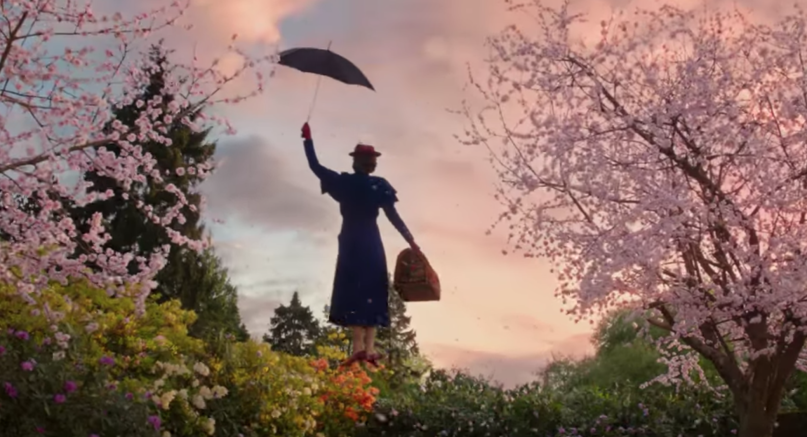Mary Poppins Returns
I won’t be referring to the 1964 original all too often, because Rob Marshall’s sequel — while a tribute of a sequel — is clearly an extension more than a remake of any sort. The title Mary Poppins Returns couldn’t be more appropriate on that note. Mary Poppins as a character is very much back, with Emily Blunt pulling off a stunner of a performance. You can learn three things from this whole Mary Poppins situation: the character is actually insane to pull off, Julie Andrews was brilliant as that character, and Blunt is brilliant as that character. There aren’t many people that can replicate the fantastical nanny’s wit, sharpness, wonder, and brief signs of joy like Andrews and Blunt. So, goal number one (find the right replacement) was pulled off effortlessly.
Step two: retain the creativity of the original. Between Marshall’s demand for 2-D animation to return (thank you so much for your fight, good sir) and the many dreamy sequences (that pastel coloured water number was to die for), you’re definitely looking at a retooling of the old ideas the original film had with modern technology. No matter what your age is, the excursions from the real world that Mary Poppins Returns can offer you is worth the price of admission. So, that’s the second mission fulfilled.
Step three: offer something new. Well, we have a statement on today’s economy by seeing the Banks children (now all grown up with children of their own) experiencing the threat of losing a house in the matter of days. While a lot of themes don’t quite cross over perfectly between the real world and the one that Poppins brings (a lot of the joy Poppins brings only loosely replicates what is actually going on), it’s still a film that relishes in its detours from the evils of the real world. The means of the characters in the film can somewhat thank Mary Poppins, perhaps for bringing joy in their life. But I’m not quite sure if telling the Banks children to view things from a new angle actually did get them to do just that (or in any way that affects the plot subsequently, anyways). You kind of feel like there is the dim brevity of the situation, and then there’s a whole new world of whimsy and splendour, with only a slight bridge to both worlds. Poppins herself is said bridge, but there are a few things that loosely make their way over (the wolf replicating the villain of the film, played by Colin Firth). If you don’t expect too much interconnectivity between fiction and reality, then Mary Poppins Returns won’t offend you too much.
The ending is one you can see a mile away, and by that I mean literally you see it. Without spoiling anything, if you have even a not-so keen eye, you might notice the key event that is necessary to turn things around for the Banks family within the first twenty minutes or so. When that gets confirmed, it almost feels cheap; this isn’t because the twist is lazy, but because you were outright given the sneak peak way too early and way too obviously. Seeing as this is Mary Poppins Returns, a plot bending thriller is not likely the reason why you are going, but part of the experience is the surprise that Poppins herself brings to almost every minute on screen. Being in-the-know so early removes the biggest surprise of them all.
Emily Blunt as Mary Poppins soaring off into the late afternoon sky.
You’re likely here for the musical numbers, though, and they do not disappoint. Aside from the final number which can overstay its welcome (it’s super lengthy, and after everything has been resolved), even a ten minute long fiesta featuring the lamplighters (and main lamplighter Jack, played fantastically by Lin-Manuel Miranda) feels like a trip that you never really want to end. For once, Marshall (who usually plays his films too safe and gets sucked up in the trivialities of his creations) has found the perfect recipe with Mary Poppins. He can be as safe as he wants (because an edgy Mary Poppins wouldn’t work too well for the whole Disney image), and his obsession with living in his own musical numbers translates very well for us in this picture. I’ve never been a big fan of Rob Marshall; this might be the first film of his that I didn’t leave underwhelmed or annoyed by.
Overall, Mary Poppins is inoffensive (save for one risqué joke that came, went, and was actually kind of funny in a shocking way). It might be flawed, but its strengths (and, let’s face it, the real reasons why most people are going to this film) make the film more than watchable. More importantly, it’s enjoyable. Out of all of these live action films Disney has been pumping out, it feels like one of the more authentic takes. Maybe because it’s a sequel and not a remake, or maybe it’s because Marshall found his calling here (with the right cast and crew, of course). Nonetheless, Mary Poppins Returns, and she hasn’t overstayed her welcome.
Andreas Babiolakis has a Masters degree in Film and Photography Preservation and Collections management from Ryerson University, as well as a Bachelors degree in Cinema Studies from York University. His favourite times of year are the Criterion Collection flash sales and the annual Toronto International Film Festival.





